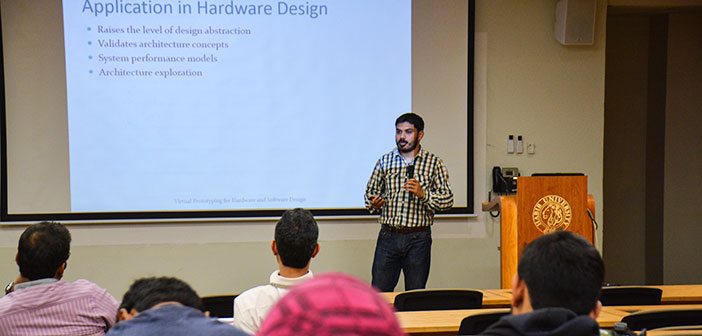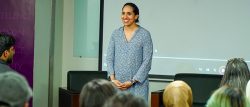Delivers talk on how new technologies can be brought to the market in quicker, more efficient ways using virtual prototyping technology
HABIB UNIVERSITY, February 9, 2016: An engineer from Intel Germany delivered a well-attended talk here at the Rashid Soorty & Family Lecture Theater. The speaker, Saad Siddiqui, had titled the talk ‘Virtual Prototyping for Hardware & Software Design’, wherein he discussed modern ways of designing hardware and software by using virtual prototypes, which not only help reduce Time-To-Market (the time it takes for a new product to be conceptualized, designed, tested and delivered to the market) but also help developers catch problems (bugs) early in the design process.
Siddiqui holds a B.E in Electronics from NED University of Engineering and Technology, and a subsequent M.Sc. in Communication Electronics from the Technical University of Munich, Germany. He has been working for more than three years at Intel German as a Virtual Prototyping Engineer.
Explaining virtual prototyping, Siddiqui said it is basically “a computer-based simulation of a system or subsystem with a degree of functional realism comparable to a physical prototype.” Breaking it down further, he said virtual prototyping involves configuring the system (virtually constructing the prototype) and then using it (simulating it).
In the first half of his talk, Siddiqui compared traditional methodologies with virtual prototypes, stressing the advantages of virtual prototyping in both hardware and software design.
Discussing the benefits offered by virtual prototyping in hardware design, he explained that at the early phases of developing a piece of hardware, design requirements and specifications used to be primarily captured on paper, and then a modeling methodology was required to capture design specifications and requirements in an “executable format”. With the help of virtual prototyping, these requirements and specifications can be narrowed down early in the process while the design is being verified through simulation.
Likewise with software, developers can minimize the delays caused in the traditional process (which involves getting a piece of hardware ready before its software can be tested out) by running the software testing process in parallel over a virtual prototype. Not only that, virtual prototyping actually offers a superior software debug environment.
Siddiqui dedicated the second half of his talk to methodologies involved in virtual prototyping – including SystemC and TLM Modeling – as well as the difference between virtual prototyping for hardware and software design.




